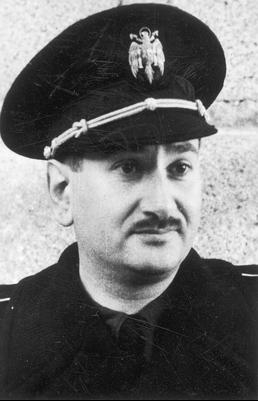José Luis de Arrese facts for kids
Quick facts for kids
José Luis de Arrese
|
|
|---|---|

Arrese circa 1939
|
|
| Born |
José Luis de Arrese y Marga
15 April 1905 |
| Died | 6 April 1986 (aged 80) |
| Nationality | Spanish |
| Education | Doctorate in architecture |
| Occupation | Architect |
| Known for | Politician |
|
Notable work
|
La Revolucion Social del Nacional Sindicalismo (1940) |
| Political party | FET y de las JONS |
José Luis de Arrese y Marga (born April 15, 1905 – died April 6, 1986) was an important Spanish politician. He was a key figure in the Falange party and its later version, the FET y de las JONS.
Contents
José Luis de Arrese: His Early Life
Arrese was born in Bilbao, a city in Spain. His family was Basque and supported a political movement called Carlism. He moved to Madrid to study architecture. In 1932, he earned his doctorate in architecture.
As a student, Arrese was part of a conservative group called Asociación de Estudiantes Catolicos. He also helped start the Federacion Espanola de Trabajadores. This was a workers' organization that focused on being against communism.
Joining the Falange Party
It's not fully clear when Arrese first joined the Falange party. Some sources say he was a founder in 1933. Others say he joined in 1936. Either way, Arrese was part of the camisa vieja (old shirt) group. This was a strict group made up of the early members of the Falange movement.
When the Spanish Civil War began, Arrese was in the Republican zone. He found safety in the Embassy of Norway. In 1937, he managed to escape to the Nationalist side. He was a close friend of Manuel Hedilla. Arrese supported Hedilla in his disagreement with Francisco Franco. Because of this, a military court working for Franco sentenced Arrese to two years in prison.
However, General Gonzalo Queipo de Llano quickly arranged for his release. General Queipo de Llano was a Franco supporter but had a good relationship with Arrese. Arrese regained some influence in December 1937. He became the main leader (jefe provincial) in Málaga. There, he helped create affordable housing and made sure fuel was available. He strongly believed in national syndicalism. This was a key idea in the original Falange party. In 1940, he published a book about it called La Revolucion Social del Nacional Sindicalismo.
His Role During World War II
Arrese was a big supporter of Nazism. He was one of the first people to suggest creating the Blue Division. This was a group of Spanish volunteers who fought with Nazi Germany in World War II.
On May 20, 1941, Francisco Franco appointed Arrese to his cabinet. Arrese became the General Secretary of the Movement. This happened when Adolf Hitler was having great success in the war. Franco's choice was smart. Even though Arrese was part of the "Old Shirt" group, he was also very loyal to Franco.
Arrese kept his strong interest in Nazism. In January 1943, he visited Nazi Germany. He met with Adolf Hitler and Joachim von Ribbentrop. He also looked at German aircraft and building projects. This was the last official meeting between Spain and Germany before Hitler's fall. Despite his support for the Nazis, Arrese told Hitler that he felt there were big differences between their ideas. Arrese was a lifelong and very religious member of the Roman Catholic Church. On July 20, 1945, Arrese was removed from his position. His role was no longer helpful for Franco's political goals. The position was left empty to show that Francoist Spain was moving away from fascism.
After the War
Arrese made a return to politics in 1956. Franco removed Raimundo Fernández-Cuesta as the leader of the Blue Shirts. However, this role was not as important anymore. The Army and those who supported the monarchy had become more powerful than the traditional Falangists.
In 1957, Arrese tried to get more power for the Falangists. He presented Franco with a new plan for the Spanish government. This plan would have made Spain a totalitarian state. He threatened to resign if it was not accepted. But Franco said no. Instead, Franco supported a plan that favored the monarchy much more. In a change of government officials, Arrese was given a very small job as Minister of Housing. By 1960, Arrese was no longer in any government role.
He became disappointed with how Spain was developing after the war. In 1958, he gave a speech on the anniversary of José Antonio Primo de Rivera's death. He said, "you [Primo de Rivera] cannot be satisfied with this mediocre, sensual life." He left his job as Minister of Housing in 1960. This happened after his request for more money for social housing was turned down. He then retired from public life. He eventually settled in Corella, where he passed away in 1986.
See also
 In Spanish: José Luis Arrese para niños
In Spanish: José Luis Arrese para niños

